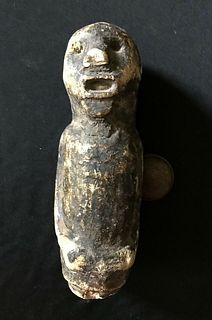20th C. Congolese Pende Wood Mask - Mbangu
Lot 97
About Seller
Artemis Fine Arts
686 S Taylor Ave, Ste 106
Louisville, CO 80027
United States
Selling antiquities, ancient and ethnographic art online since 1993, Artemis Gallery specializes in Classical Antiquities (Egyptian, Greek, Roman, Near Eastern), Asian, Pre-Columbian, African / Tribal / Oceanographic art. Our extensive inventory includes pottery, stone, metal, wood, glass and textil...Read more
Estimate:
$2,800 - $4,200
Absentee vs Live bid
Two ways to bid:
- Leave a max absentee bid and the platform will bid on your behalf up to your maximum bid during the live auction.
- Bid live during the auction and your bids will be submitted real-time to the auctioneer.
Bid Increments
| Price | Bid Increment |
|---|---|
| $0 | $25 |
| $300 | $50 |
| $1,000 | $100 |
| $2,000 | $250 |
| $5,000 | $500 |
| $10,000 | $1,000 |
| $20,000 | $2,500 |
| $50,000 | $5,000 |
| $100,000 | $10,000 |
| $200,000 | $20,000 |
About Auction
By Artemis Fine Arts
Nov 4, 2021
Set Reminder
2021-11-04 10:00:00
2021-11-04 10:00:00
America/New_York
Bidsquare
Bidsquare : Ancient & Ethnographic Art Through The Ages
https://www.bidsquare.com/auctions/artemis-gallery/ancient-ethnographic-art-through-the-ages-7799
Ancient art from Egypt, Greece, Italy and the Near East, as well as Asian, Fossils, Pre-Columbian, Native American, African / Tribal / Oceanic, Fine art, and much more! All categories, all price ranges... all legally acquired and guaranteed to be as described or your money back. Artemis Fine Arts info@artemisfinearts.com
Ancient art from Egypt, Greece, Italy and the Near East, as well as Asian, Fossils, Pre-Columbian, Native American, African / Tribal / Oceanic, Fine art, and much more! All categories, all price ranges... all legally acquired and guaranteed to be as described or your money back. Artemis Fine Arts info@artemisfinearts.com
- Lot Description
Africa, Democratic Republic of the Congo, Western Pende, ca. early to mid-20th century CE. A fascinating, hand-carved wood mask known as an mbuya mask, which are used to depict different characters during traditional rituals. This example is called mbangu and represents a person who is diseased - a condition the Pende often attributed to witchcraft or moral corruption. The distorted visage is bisected vertically by white and black pigments. This visual dualism is symbolic of the opposing forces of good and evil or illness and health with the white representing the spirits of the deceased and hope of recovery, while the black is sickness. The expressive vizard presents a contorted expression of heavy-lidded downcast eyes with openings for the user, a broad, twisted nose, and an open mouth dramatically angled to the wearer's left. Size: 8" W x 10" H (20.3 cm x 25.4 cm); 14.4" H (36.6 cm) on included custom stand.
Mbuya masks, like this one, were traditionally considered tools or transistors for facilitating communion between the worlds of the living and the dead. Since the mid-20th century however, they have mostly been used for entertainment during adult initiation rituals. The University of Michigan Museum of Art describes how one who wears a mbunga mask would perform during such a ritual, writing, "In order to emphasize the character’s infirmity during a dance, a performer limped on a cane and either wore a hump on his back pierced by an arrow or carried bows and and [sic] arrows upon his belt, a reference to metaphorically shooting one’s prey by casting an evil spell. Ultimately, the mbangu visually illustrates for audience members the belief that affliction is often the result of malice from others and can strike anyone at any moment; therefore, one should not ridicule those stricken but extend support and compassion."
Cf. Museum of Fine Arts in Boston, accession number 2014.159 and University of Michigan Museum of Art, accession number 2005/1.200.
A similar mbangu mask of slightly smaller scale with a raffia headdress was sold by Christie's London on February 8th, 2012 for 37,250 British sterling (equivalent to about $50,697) as lot 615 in their "Living with Art - A Private European Collection, Evening Sale" (Live Auction 8054).
Provenance: private New York, New York, USA collection; ex-Fily Keita collection, Los Angeles, California, USA
All items legal to buy/sell under U.S. Statute covering cultural patrimony Code 2600, CHAPTER 14, and are guaranteed to be as described or your money back.
A Certificate of Authenticity will accompany all winning bids.
PLEASE NOTE: Due to recent increases of shipments being seized by Australian & German customs (even for items with pre-UNESCO provenance), we will no longer ship most antiquities and ancient Chinese art to Australia & Germany. For categories of items that are acceptable to ship to Australia or Germany, please contact us directly or work with your local customs brokerage firm.
Display stands not described as included/custom in the item description are for photography purposes only and will not be included with the item upon shipping.
#166675Expected nicks and abrasions, commensurate with age and use. Old inactive insect holes. Otherwise, intact and excellent with impressive remaining pigments.Condition
- Shipping Info
-
All shipping is handled in-house for your convenience. Your invoice from Artemis Gallery will include shipping calculation instructions. If in doubt, please inquire BEFORE bidding for estimated shipping costs for individual items.
-
- Buyer's Premium



 EUR
EUR CAD
CAD AUD
AUD GBP
GBP MXN
MXN HKD
HKD CNY
CNY MYR
MYR SEK
SEK SGD
SGD CHF
CHF THB
THB














